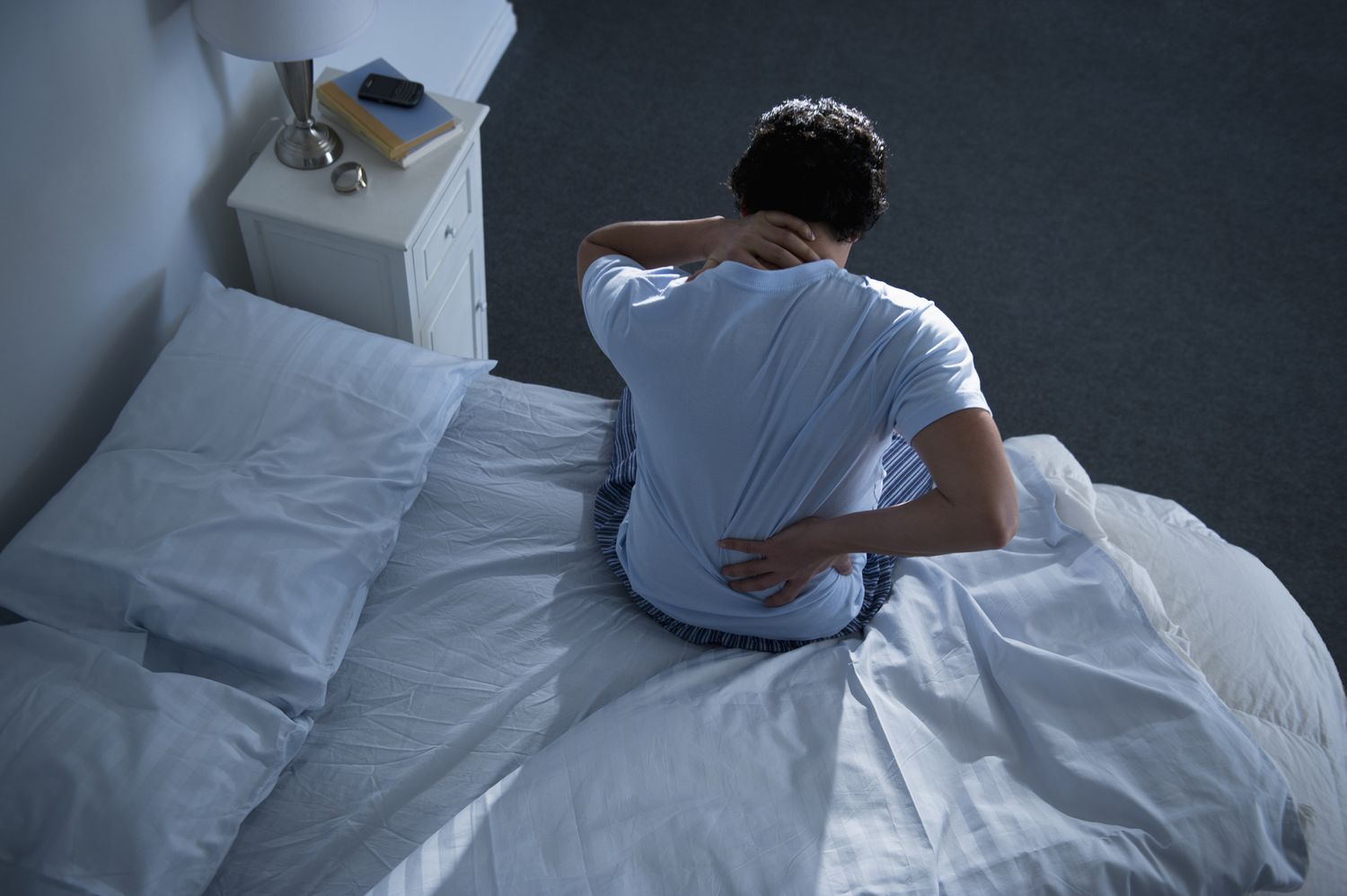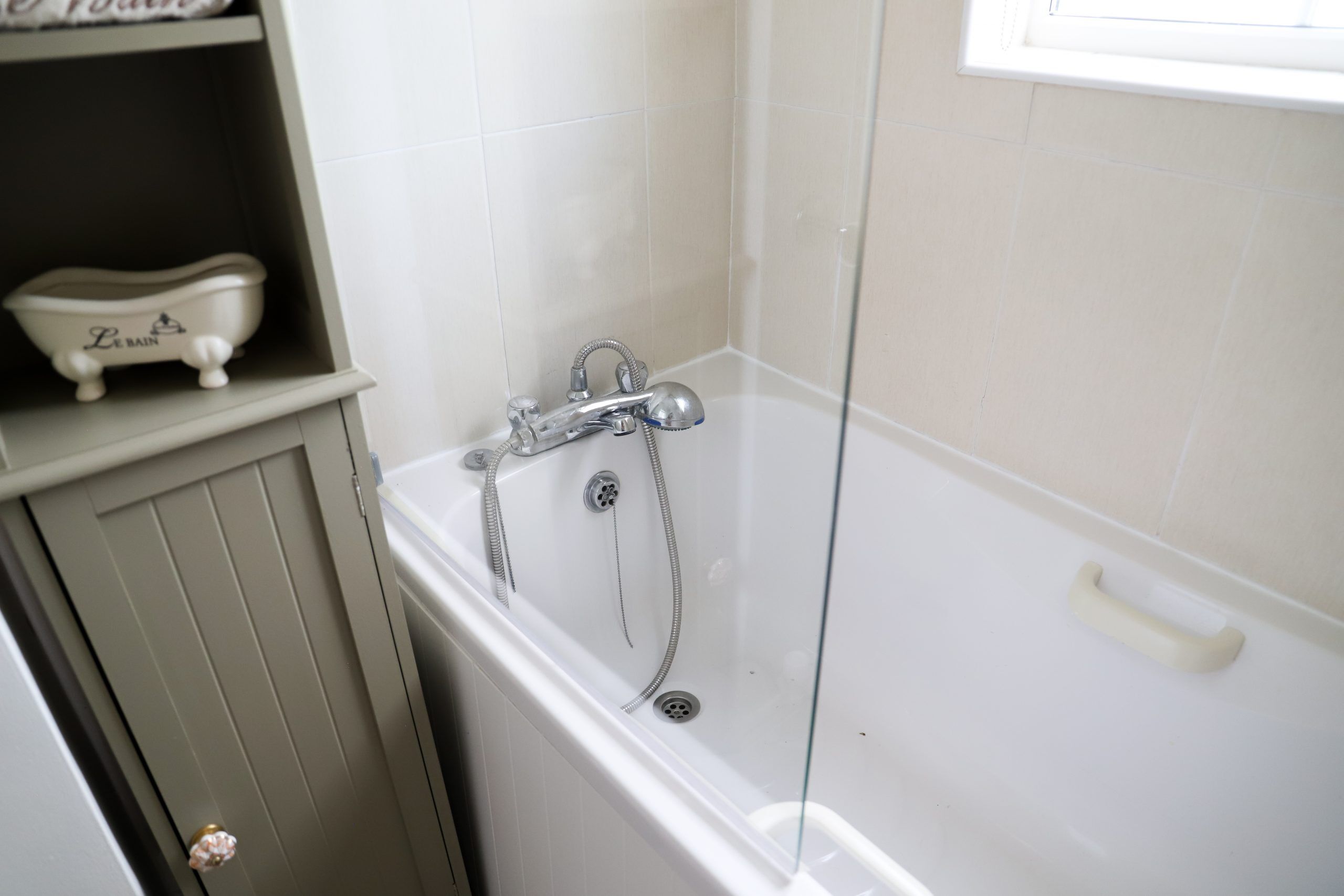Home>Furniture>Bedroom Furniture>Why Does My Bed Hurt My Back


Bedroom Furniture
Why Does My Bed Hurt My Back
Modified: October 20, 2024
Discover why your bed is causing back pain and explore solutions with our expert guide on choosing the right bedroom furniture.
(Many of the links in this article redirect to a specific reviewed product. Your purchase of these products through affiliate links helps to generate commission for Storables.com, at no extra cost. Learn more)
Introduction
Are you waking up with back pain every morning? Does your bed feel like an enemy instead of a sanctuary? If so, you’re not alone. Many people struggle with back pain that can be traced back to their bed. In this article, we’ll explore why your bed may be hurting your back and provide tips on how to alleviate the discomfort.
Our beds are supposed to provide us with a restful and rejuvenating sleep, but sometimes they can do more harm than good. Back pain from a bed can occur due to several factors, such as mattress firmness, lack of support, improper pillow selection, sleeping position, and even the type of beddings used.
Before understanding how your bed can contribute to back pain, it’s essential to recognize the importance of a good night’s sleep. Sleep plays a crucial role in our overall health and well-being. It allows our bodies to repair and restore themselves, so we wake up feeling refreshed and ready to take on the day. However, chronic back pain can disrupt our sleep, leading to a vicious cycle of discomfort and fatigue.
Now, let’s delve into the main causes of back pain from a bed and explore potential solutions to help you wake up with a happy and pain-free back.
Key Takeaways:
- Choosing the right mattress firmness, pillow, and sleep position is crucial for alleviating back pain. Pay attention to your body’s needs and make informed decisions to create a sleep environment that promotes comfort and support.
- Back pain from a bed can be addressed by evaluating mattress support, pillow selection, and bedding choices. Experiment with different options to find what works best for your individual needs and preferences.
Read more: Why Does My Recliner Hurt My Back
Causes of Back Pain from a Bed
There are several factors that can contribute to back pain from a bed, including:
- Mattress Firmness: The firmness of your mattress plays a significant role in determining the level of support your back receives while sleeping. A mattress that is too soft can cause your spine to sink, leading to misalignment and increased pressure on the lower back. On the other hand, a mattress that is too firm might not provide enough cushioning, leading to discomfort and pain.
- Mattress Support: In addition to firmness, the support of your mattress is crucial for preventing back pain. A sagging or worn-out mattress may not provide adequate support to your spine, leading to improper alignment and strain on the muscles and joints.
- Pillow Selection: The type and quality of your pillow can also contribute to back pain. Using a pillow that is too flat or too thick can disrupt the natural curvature of your spine, causing strain and discomfort. It is important to choose a pillow that adequately supports your neck while keeping your spine aligned.
- Sleeping Positions: Your sleeping position can put additional stress on your back if not properly supported. For example, sleeping on your stomach can strain the neck and lower back, while sleeping on your side can cause the spine to twist. The ideal sleeping position for back health is on your back or side, with proper support for your neck and spine.
- Beddings: The type of beddings you use, such as sheets and blankets, can also impact your back health. Beddings that are too tight or restrictive can limit movement during sleep, leading to stiffness and discomfort. Opt for beddings that allow for easy movement and breathability.
It’s important to keep in mind that the ideal bed setup will vary from person to person. What works for someone else may not work for you, so it’s essential to pay attention to your own comfort and personal needs. Next, we’ll explore how to address these issues to alleviate back pain from your bed.
Mattress Firmness and Back Pain
One of the key factors in determining the comfort and support of a bed is its firmness. However, finding the right level of firmness is crucial, as it can greatly impact back pain. Let’s take a closer look at how mattress firmness affects back pain:
1. Too Soft: Sleeping on a mattress that is too soft can be problematic for your back. A soft mattress allows your body to sink in too deeply, causing your spine to curve unnaturally and leading to increased pressure on the lower back. This can result in morning stiffness and back pain that persists throughout the day.
2. Too Firm: On the other hand, a mattress that is too firm can also contribute to back pain. A firm mattress does not provide enough give to support the natural curvature of your spine. It can create pressure points on your hips, shoulders, and back, leading to discomfort and pain.
3. Finding the Right Balance: The ideal mattress firmness varies from person to person, depending on factors such as body weight, sleeping position, and personal preference. Generally, a medium-firm mattress is recommended for optimal support and comfort. This level of firmness provides a balance between support and cushioning, allowing your spine to align properly while relieving pressure points.
4. Testing the Firmness: When purchasing a new mattress, it’s important to test out different firmness levels to determine which one feels most comfortable for your back. Visit a mattress store and spend some time lying down in different positions to get a feel for how the mattress supports your body. If shopping online, check customer reviews and ratings for insights on firmness.
5. Consider Memory Foam: Memory foam mattresses have gained popularity due to their ability to contour to your body, providing targeted support and pressure relief. The foam molds to your body shape, promoting proper spinal alignment and reducing the risk of back pain. However, it’s crucial to choose a memory foam mattress with adequate firmness to avoid sinking too deeply.
Remember, finding the right mattress firmness is a personal choice. Take your time to research, test different options, and listen to your body’s needs. A mattress that properly supports your spine can go a long way in reducing back pain and promoting a restful sleep.
Mattress Support and Back Pain
In addition to firmness, the support of your mattress is another essential factor that can contribute to back pain. A mattress that lacks proper support can lead to misalignment of the spine, causing discomfort and pain. Let’s explore how mattress support impacts back pain:
1. Inadequate Support: If your mattress is sagging or worn out, it may no longer provide the necessary support your back needs. Over time, mattresses can lose their integrity, especially if they are made of lower-quality materials. This lack of support can result in your spine sinking into the mattress, causing misalignment and increased pressure on the back muscles and joints.
2. Proper Alignment: A mattress with good support will help maintain the natural alignment of your spine. It should provide adequate support to the different curves of your body, including the lumbar (lower back) region, which is prone to pain and discomfort. When your spine is properly aligned during sleep, it can reduce stress on the back and promote better spinal health.
3. Choose the Right Type of Support: There are several types of mattress support systems available, including innerspring, memory foam, latex, and hybrid mattresses. Each type offers different levels of support and responsiveness. Innerspring mattresses, for example, have interconnected coils that provide firm support, while memory foam mattresses conform to your body’s shape for targeted support. Consider your personal preference and specific needs when selecting a mattress with the right support system.
4. Mattress Age: It’s worth noting that even if your mattress originally provided good support, it may lose its efficacy over time. On average, mattresses have a lifespan of around 7-10 years. If you’ve had your mattress for longer than that, it may be time for a replacement to ensure proper support for your back.
5. Additional Support Options: If you find that your current mattress lacks support, there are options to enhance its supportiveness. Mattress toppers or inserts can be used to provide additional cushioning and support to an older mattress. Additionally, using a solid foundation or platform bed can help distribute the weight evenly and provide better support.
Remember, proper mattress support is crucial for maintaining a healthy spine and reducing back pain. Take the time to assess your current mattress and consider investing in one that offers the right level of support for your needs. Your back will thank you for it!
Pillow Selection and Back Pain
When it comes to back pain, the right pillow can make a significant difference in promoting a comfortable and pain-free sleep. Your pillow plays a crucial role in supporting your neck and spine alignment, which can impact the health of your back. Here are some important factors to consider when selecting a pillow to alleviate back pain:
1. Pillow Height: The height or thickness of your pillow should correspond to your sleeping position to maintain proper alignment of your neck and spine. For back sleepers, a medium loft pillow that supports the natural curve of the neck is recommended. Side sleepers may benefit from a higher loft pillow to keep the head and neck aligned with the spine. Stomach sleepers, however, should choose a low loft pillow to prevent excessive bending of the neck.
2. Pillow Material: Pillows are available in a variety of materials, including memory foam, latex, down, and polyester. Each material offers different levels of support and comfort. Memory foam pillows, for instance, contour to the shape of your head and neck, providing personalized support and pressure relief. Latex pillows are resilient and supportive, while down pillows are soft and offer a plush feel. Consider your personal preferences and any specific neck or back issues when selecting the pillow material.
3. Pillow Firmness: Like mattresses, pillows come in different levels of firmness. It is essential to choose a pillow that provides adequate support while still offering optimal comfort. A pillow that is too firm can cause strain on the neck and back, whereas a pillow that is too soft may not provide sufficient support. Experiment with different firmness levels to find the one that best suits your needs.
4. Pillow Shape: Some pillows are designed with specific shapes to cater to different sleeping positions or alleviate certain health conditions. For example, cervical pillows have a contoured shape that supports the natural curve of the neck for back sleepers. Wedge pillows can be useful for elevating the upper body to alleviate acid reflux or snoring. Consider your individual needs and any specific health concerns when choosing a pillow shape.
5. Regular Pillow Replacement: It’s important to replace your pillow regularly, as it can lose its shape and support over time. As a general rule of thumb, consider replacing your pillow every 1 to 2 years, or when you notice it has become lumpy or flattened. A worn-out pillow can no longer provide the necessary support for your neck and back, leading to discomfort and pain.
Choosing the right pillow is a personal decision based on your sleep preferences and specific needs. Take the time to experiment with different pillow options and find the one that offers the best support and comfort for your back. A well-chosen pillow can improve your sleep quality and alleviate back pain.
Try placing a pillow under your knees when lying on your back to help maintain the natural curve of your spine and reduce pressure on your lower back.
Read more: Why Does My Mattress Make My Back Hurt
Sleeping Positions and Back Pain
Your sleeping position can greatly impact the health of your back and contribute to back pain. The position you sleep in affects the alignment of your spine and the amount of pressure placed on your back muscles and joints. Let’s explore the different sleeping positions and how they can affect back pain:
1. Back Sleeping: Sleeping on your back is generally considered the best position for spinal alignment and reducing back pain. When sleeping on your back, it’s important to choose a pillow that supports the natural curve of your neck and keeps your head aligned with your spine. Additionally, placing a small pillow or rolled-up towel under your knees can help maintain the natural curvature of your lower back.
2. Side Sleeping: Side sleeping is a common position, but it may not be the best for back pain sufferers. When sleeping on your side, it’s important to keep your spine aligned by using a pillow that supports both your head and neck. Additionally, placing a pillow between your knees can help alleviate strain on the lower back by keeping your spine in a more neutral position.
3. Stomach Sleeping: Sleeping on your stomach can put strain on your back and neck. When you sleep on your stomach, your spine is forced into an unnatural and strained position, causing potential discomfort and pain. If you can’t break the habit of stomach sleeping, try using a thin pillow or no pillow at all to minimize the strain on your neck and lower back.
4. Changing Positions: It’s common to change positions during the night, especially if you’re experiencing discomfort. If you tend to wake up with back pain, try adjusting your sleeping position. For example, if you’re a stomach sleeper, try transitioning to sleeping on your back or side to promote better spinal alignment. However, be mindful that changing sleeping positions may require time and practice to adjust.
5. Listen to Your Body: Ultimately, the best sleeping position for your back is the one that feels most comfortable and allows for proper spinal alignment. Pay attention to your body’s cues and make adjustments accordingly. If you consistently wake up with back pain, it may be worth discussing your sleep position with a healthcare professional or chiropractor for personalized guidance.
In addition to adjusting your sleeping position, it’s important to create a sleep environment that promotes comfort and relaxation. Invest in a supportive mattress and pillow, maintain a consistent sleep schedule, and practice good sleep hygiene habits to maximize your chances of waking up with a pain-free back.
Beddings and Back Pain
When it comes to back pain, the type of beddings you use can play a role in either exacerbating or alleviating your discomfort. The right beddings can contribute to a comfortable and supportive sleep environment, while the wrong ones can contribute to pain and stiffness. Let’s explore how bedding choices can impact back pain:
1. Mattress Topper: A mattress topper can be a valuable addition to your bed if you’re experiencing back pain. Toppers can provide an extra layer of cushioning and support to your mattress, helping to relieve pressure points and promote better spinal alignment. Look for a topper with materials that offer both comfort and support, such as memory foam or latex.
2. Sheets and Pillowcases: The fabric used for your sheets and pillowcases can make a difference in how comfortable you feel during sleep. Opt for breathable and soft materials, such as cotton or bamboo, that allow for airflow and reduce the chances of waking up sweaty or overheated. The right sheets and pillowcases can enhance your overall sleep quality and prevent unnecessary discomfort.
3. Bedding Tightness: The tightness of your sheets and blankets can impact your comfort level and restrict your movement during sleep. If your bedding is too tight, it can limit your ability to move freely, leading to potential muscle stiffness and back pain in the morning. Make sure the sheets are snug but not overly tight, allowing for easy movement and proper circulation.
4. Pillow Support: In addition to the pillow itself, the way you position and support your pillows can affect your back. Ensure that your pillows are properly fluffed and positioned to provide adequate support to your neck and head. Improper pillow support can lead to strained neck muscles and contribute to back pain.
5. Comfortable Blankets and Weighted Blankets: Choosing a comfortable and appropriately weighted blanket can contribute to relaxation and help reduce muscle tension. Some people find relief from back pain by using a weighted blanket, which provides gentle pressure and promotes a sense of security and comfort during sleep. Experiment to find the blankets that provide the right level of comfort and support for your specific needs.
Remember, everyone’s preferences and needs vary, so it’s important to find the beddings that work best for you. Pay attention to the comfort, support, and breathability of your beddings to create an environment that promotes restful sleep and helps alleviate back pain.
Signs that Your Bed is Causing Back Pain
Back pain can often be attributed to a variety of factors, and one potential culprit may be your bed. If you frequently wake up with back pain, it’s essential to evaluate whether your bed could be the source of your discomfort. Here are some common signs that your bed may be causing your back pain:
1. Consistent Morning Stiffness: If you regularly wake up with stiffness and soreness in your back that gradually improves throughout the day, it could be a sign that your bed is not providing adequate support. Insufficient support can lead to misalignment of the spine, causing muscle tension and stiffness.
2. Tossing and Turning: Do you find yourself tossing and turning frequently during the night, trying to find a comfortable position? If your bed fails to provide a comfortable and supportive surface, you may end up constantly shifting positions to alleviate pain or discomfort. Continuous movement during sleep can lead to disrupted sleep patterns and contribute to back pain.
3. Visible Sagging or Wear: Take a close look at your mattress for any visible signs of sagging or wear. Over time, mattresses can lose their integrity and no longer provide proper support. If you notice significant sagging or indents in your mattress, it’s likely time for a replacement. A worn-out mattress can lead to an improper alignment of the spine and contribute to back pain.
4. Uncomfortable Lumps or Springs: Feeling uncomfortable lumps or springs poking through your mattress is a clear indication that your bed is no longer providing the support and cushioning you need. These uneven surfaces can cause pressure points and strain on your back, contributing to pain and discomfort.
5. Lack of Relief with Position Changes: If you find that changing your sleeping position doesn’t alleviate your back pain, it’s possible that your bed is the underlying issue. A mattress that doesn’t properly support your body’s natural curves can lead to increased pressure and stress on your back, regardless of your sleep position.
6. Improved Comfort Elsewhere: If you notice that you experience less back pain when sleeping in a different bed, such as a hotel or a friend’s house, it may be a sign that your own bed is causing or contributing to your discomfort. This suggests that the problem lies with the quality or supportiveness of your mattress.
If you’re experiencing one or more of these signs, it’s time to consider whether your bed is causing your back pain. Investing in a new mattress or making adjustments to improve the support and comfort of your bed can greatly impact your sleep quality and alleviate back pain.
Tips to Relieve Back Pain from Your Bed
If you’re experiencing back pain from your bed, there are several steps you can take to alleviate the discomfort and promote a healthier sleep environment. Here are some tips to help relieve back pain and improve your overall sleep quality:
1. Choose the Right Mattress: Invest in a mattress that provides the right level of firmness and support for your body. A medium-firm mattress is generally a good choice as it offers a balance of support and comfort. Consider your personal preferences, sleep position, and any specific back issues when choosing a mattress.
2. Consider Mattress Toppers or Inserts: If your current mattress is causing discomfort, a mattress topper or insert can provide an extra layer of cushioning and support. Look for options made of memory foam or latex to contour to your body and alleviate pressure points.
3. Evaluate Your Pillow: Ensure that your pillow adequately supports your neck and keeps your spine aligned. Choose a pillow with the appropriate height and firmness based on your sleeping position. Consider memory foam or latex pillows for optimal support and pressure relief.
4. Optimize Your Sleep Position: Experiment with different sleep positions to find the one that puts the least strain on your back. Back sleepers can place a pillow under their knees, side sleepers can use a pillow between their knees, and stomach sleepers may consider transitioning to a different position that promotes better spinal alignment.
5. Practice Good Sleep Posture: Pay attention to your posture while sleeping. Avoid slouching or sinking into your mattress, as this can lead to back strain. Instead, strive for a neutral spine alignment and maintain proper support for your head, neck, and lower back.
6. Stretch and Strengthen: Incorporate regular stretching and strengthening exercises into your daily routine to improve overall back health and reduce pain. Consult with a healthcare professional or physical therapist for exercises specifically tailored to your condition.
7. Consider a Supportive Mattress Foundation: Ensure that your mattress is placed on a sturdy and supportive foundation or bed frame. A sagging or worn-out foundation can compromise the supportiveness of your mattress and contribute to back pain.
8. Maintain a Healthy Weight: Excess weight can put strain on your back and contribute to back pain. Maintain a healthy weight through a balanced diet and regular exercise to reduce the stress on your spine.
9. Listen to Your Body: Pay attention to how your body reacts to different sleeping surfaces, positions, or changes you make to your bed. Everyone’s needs are different, so find what works best for you to alleviate your back pain.
If your back pain persists or worsens despite implementing these tips, it’s advisable to consult with a healthcare professional or a sleep specialist for a comprehensive evaluation and guidance tailored to your specific needs. Remember, finding the right combination of mattress, pillow, and sleep position can greatly impact your sleep quality and contribute to a pain-free back.
Read more: Why Does Memory Foam Hurt My Back
Conclusion
Back pain is a common issue that can significantly impact our overall well-being and quality of life. If you’re experiencing back pain, it’s important to consider the role that your bed plays in contributing to your discomfort. By addressing the factors that can cause back pain from a bed, you can create a sleep environment that promotes comfort, support, and a restful night’s sleep.
We explored various factors that can affect back pain, including mattress firmness, mattress support, pillow selection, sleeping positions, and beddings. Understanding how these factors can impact your back can help you make informed decisions to alleviate back pain and improve sleep quality. Remember, what works for one person may not work for another, so it’s essential to find the solutions that suit your individual needs and preferences.
When it comes to choosing a mattress, opt for one that offers the right firmness and support for your body. Consider mattress toppers or inserts to add an extra layer of comfort and cushioning. Pay attention to your pillow, selecting one that supports your neck and spine alignment based on your sleeping position. Experiment with different sleep positions and practice good sleep posture to minimize strain on your back.
Additionally, be mindful of the beddings you use. Choose breathable materials for sheets and pillowcases, and avoid overly tight bedding that restricts movement. Take note of any visible signs of wear on your mattress, such as sagging or lumps, as this may indicate the need for a replacement. Investing in a supportive mattress foundation or bed frame is also important for maintaining proper mattress support.
Remember to listen to your body and make adjustments accordingly. If you experience persistent or worsening back pain, consult with a healthcare professional or sleep specialist for personalized recommendations. They can provide further guidance and help you determine the underlying causes of your back pain.
Ultimately, a comfortable and supportive bed plays a vital role in ensuring restful sleep and promoting a healthy back. By implementing these tips and making informed choices, you can take steps toward relieving back pain and waking up refreshed and pain-free.
Frequently Asked Questions about Why Does My Bed Hurt My Back
Was this page helpful?
At Storables.com, we guarantee accurate and reliable information. Our content, validated by Expert Board Contributors, is crafted following stringent Editorial Policies. We're committed to providing you with well-researched, expert-backed insights for all your informational needs.













